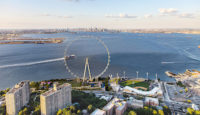It might be hard to believe, but there was a time when Skanska considered itself something of an unknown in the U.S. construction market.
We were always kind of a giant that no one ever knew much about,� says Richard Cavallaro, president of Skanska USA Civil, one of the Swedish construction giant�s four business units in North America. People would ask us, �Where do you work?� and when you�d say Skanska, they'd say, "Who?"
For awhile, it made sense. Once the firm entered the U.S. market in 1971, it began acquiring firms both small and large throughout the region and continued operating them under different names. By the time they were all brought under the Skanska brand in the 1990s they had four unique business units � Skanska USA Building, Skanska USA Civil, Skanska Commercial Development and Skanska Infrastructure Development � and a growing reputation.
Now they�ve become impossible to miss.
If you do a quick rundown of the New York region�s biggest construction projects, chances are, Skanska�s logo is on the site somewhere.
New Meadowlands Stadium in East Rutherford? Check.
2nd Avenue Subway and 7 Line Subway extension in Manhattan? Check.
The $500 million Brooklyn Bridge Rehabilitation? Check
United Nations renovation? Check
In 2009 Skanska USA�s Northeast operations did nearly $2.4 billion worth of business in New York, New Jersey and Connecticut, more than any other contractor in the region. There are only a handful of billion-dollar jobs left in the New York region and, within the last year, Skanska has completed, started work or been awarded large contracts on 10 of them. For their dominant year, which occurred in the most challenging economic environment the industry has experienced in nearly 20 years, Skanska has been named New York Construction magazine�s Contractor of the Year.
Over the course of three weeks in May and early June, and including a trip to the site of their massive Fulton Street Transit Center project in Lower Manhattan, we spoke to Skanska�s top U.S. executive team � Cavallaro, Mike McNally, president and CEO of Skanska USA; and Bill Flemming, president of Skanska USA Building � about their success over the last year and the company�s plans for the future.
New York Construction: What was the separator for Skanska over the last year or 18 months?
Richard Cavallaro: I think the honest answer to that question is that the separator wasn�t really last year. Civil projects are very long term projects � three, four, five-year projects. Sometimes longer. So a lot of the work that was paying dividends last year, we got in 2006, 2007. Everything just started ramping up at the same time. There was a really hot market for a while there and we got the opportunity to get some really big megaprojects. On the civil side alone, we had four separate billion-dollar projects going at once and Building had at least two with the Meadowlands and the U.N. So at the end of the day, you�re looking at six jobs over $1 billion in the New York region. And all but one of them are still going on (Meadowlands).
Bill Flemming: It really did start a few years ago. When lots of contractors were building high-rise condos in New York City we decided we wanted to focus on sports, education, health care and parks. We didn�t necessarily look to jump into those high-profile kinds of commercial jobs back then. And that was quite a successful strategy for us that really started to pay off in the last couple of years.
NYC: So these megaprojects were kind of once-in-a-generation type jobs for you and they all happened to be going on at the same time? The age of the megaproject in the New York region is pretty much over, but the ones that are left, it seems Skanska has a piece of just about every one of them. I guess you�d call that a perfect storm �
Mike McNally: Just about. The World Trade Center work we�re doing was a recent award, the Brooklyn Bridge, that�s a huge job we just got, but there are definitely fewer and fewer elephants in the forest, but they�re still out there. There�s the Goethals Bridge coming up, the ARC Tunnels � we�re excited about New York right now. That�s the great thing about this market. It continues. We consider ourselves fortunate, but that�s a lot of hard work that went into getting those jobs.
RC: The most powerful thing about being on these big jobs is employee pride. When you�re doing the Brooklyn Bridge, the Empire State Building, the subways, the U.N., these big waste treatment plants, the World Trade Center or the new Giants stadium, there�s hardly anyplace you can go where you can�t see a project that has Skanska�s sign on it. What that does for morale and pride is great. It helps us get the best people. Now you go home from work and people come up to you saying they�ve seen the Skanska sign on this big project or that big project. That�s pretty cool to us.
MM:I would say that�s why you�re in this business. I mean, what a sense of pride. You go to a site, there�s nothing, and you leave something. And � we�ve all done this � but I�ll go around and see our old projects and say, �I built that, and I built that and I built that.� This is a tough business, so it�s really gratifying to be able to say when it�s all done that you built something. You left that city or that neighborhood or that community better than you found it. And the more complicated the better! For us, that�s really the defining characteristic of any individual project. Is it complicated, is it tough. We love that.
NYC: You said Skanska wasn�t well known � why is that?
MM: I don�t know, to be honest. I guess a big reason is simply that we�re builders, not marketers.
div id="articleExtras"








